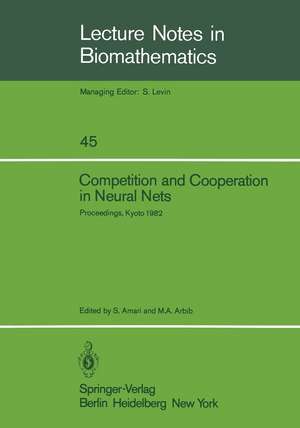Competition and Cooperation in Neural Nets: Proceedings of the U.S.-Japan Joint Seminar held at Kyoto, Japan February 15–19, 1982: Lecture Notes in Biomathematics, cartea 45
Editat de S. Amari, Ma Arbiben Limba Engleză Paperback – iul 1982
Din seria Lecture Notes in Biomathematics
-
 Preț: 378.54 lei
Preț: 378.54 lei -
 Preț: 380.45 lei
Preț: 380.45 lei -
 Preț: 413.37 lei
Preț: 413.37 lei -
 Preț: 390.63 lei
Preț: 390.63 lei -
 Preț: 396.24 lei
Preț: 396.24 lei -
 Preț: 387.38 lei
Preț: 387.38 lei -
 Preț: 385.08 lei
Preț: 385.08 lei - 5%
 Preț: 366.56 lei
Preț: 366.56 lei -
 Preț: 384.70 lei
Preț: 384.70 lei -
 Preț: 388.13 lei
Preț: 388.13 lei -
 Preț: 394.29 lei
Preț: 394.29 lei - 5%
 Preț: 389.93 lei
Preț: 389.93 lei - 5%
 Preț: 370.74 lei
Preț: 370.74 lei -
 Preț: 384.86 lei
Preț: 384.86 lei -
 Preț: 387.96 lei
Preț: 387.96 lei -
 Preț: 404.29 lei
Preț: 404.29 lei -
 Preț: 391.61 lei
Preț: 391.61 lei -
 Preț: 384.48 lei
Preț: 384.48 lei -
 Preț: 384.48 lei
Preț: 384.48 lei -
 Preț: 383.71 lei
Preț: 383.71 lei -
 Preț: 379.68 lei
Preț: 379.68 lei -
 Preț: 384.09 lei
Preț: 384.09 lei -
 Preț: 405.66 lei
Preț: 405.66 lei -
 Preț: 379.48 lei
Preț: 379.48 lei -
 Preț: 400.65 lei
Preț: 400.65 lei -
 Preț: 385.25 lei
Preț: 385.25 lei -
 Preț: 390.25 lei
Preț: 390.25 lei -
 Preț: 395.47 lei
Preț: 395.47 lei -
 Preț: 378.71 lei
Preț: 378.71 lei -
 Preț: 382.95 lei
Preț: 382.95 lei - 15%
 Preț: 578.01 lei
Preț: 578.01 lei -
 Preț: 380.84 lei
Preț: 380.84 lei -
 Preț: 405.66 lei
Preț: 405.66 lei -
 Preț: 399.12 lei
Preț: 399.12 lei -
 Preț: 410.66 lei
Preț: 410.66 lei -
 Preț: 385.62 lei
Preț: 385.62 lei - 5%
 Preț: 371.10 lei
Preț: 371.10 lei -
 Preț: 378.71 lei
Preț: 378.71 lei -
 Preț: 386.99 lei
Preț: 386.99 lei -
 Preț: 350.30 lei
Preț: 350.30 lei -
 Preț: 383.33 lei
Preț: 383.33 lei -
 Preț: 408.54 lei
Preț: 408.54 lei -
 Preț: 398.53 lei
Preț: 398.53 lei -
 Preț: 399.67 lei
Preț: 399.67 lei -
 Preț: 391.79 lei
Preț: 391.79 lei -
 Preț: 384.86 lei
Preț: 384.86 lei -
 Preț: 401.61 lei
Preț: 401.61 lei -
 Preț: 392.60 lei
Preț: 392.60 lei -
 Preț: 406.05 lei
Preț: 406.05 lei
Preț: 401.61 lei
Nou
Puncte Express: 602
Preț estimativ în valută:
76.86€ • 83.46$ • 64.56£
76.86€ • 83.46$ • 64.56£
Carte tipărită la comandă
Livrare economică 22 aprilie-06 mai
Preluare comenzi: 021 569.72.76
Specificații
ISBN-13: 9783540115748
ISBN-10: 3540115749
Pagini: 464
Ilustrații: XIV, 441 p.
Dimensiuni: 170 x 244 x 24 mm
Greutate: 0.74 kg
Editura: Springer Berlin, Heidelberg
Colecția Springer
Seria Lecture Notes in Biomathematics
Locul publicării:Berlin, Heidelberg, Germany
ISBN-10: 3540115749
Pagini: 464
Ilustrații: XIV, 441 p.
Dimensiuni: 170 x 244 x 24 mm
Greutate: 0.74 kg
Editura: Springer Berlin, Heidelberg
Colecția Springer
Seria Lecture Notes in Biomathematics
Locul publicării:Berlin, Heidelberg, Germany
Public țintă
ResearchCuprins
I. An Opening Perspective.- 1. Competitive and Cooperative Aspects in Dynamics of Neural Excitation and Self-Organization.- II. Reaction-Diffusion Equations.- 2. Sigmoidal Systems and Layer Analysis.- 3. Asymptotic Behavior of Stationary Homogeneous Neuronal Nets.- 4. Aggregation and Segregation Phenomena in Reaction-Diffusion Equations.- III. Single-Neuron and Stochastic Models.- 5. Nerve Pulse Interactions.- 6. Micronetworks in Nerve Cells.- 7. Role and Use of Noise in Biological Systems.- 8. Stochastic, Quantal Membrane Conductances and Neuronal Function.- 9. Diffusion Approximations and Computational Problems for Single Neurons’ Activity.- 10. Periodic Pulse Sequences Generated by an Analog Neuron Model.- 11. On a Mathematical Neuron Model.- IV. Oscillations in Neural Networks.- 12. Control of Distributed Neural Oscillators.- 13. Characteristics of Neural Network with Uniform Structure.- V. Development and Plasticity of the Visual Systems.- 14. Systems Matching and Topographic Maps: The Branch-Arrow Model (BAM).- 15. Differential Localization of Plastic Synapses in the Visual Cortex of the Young Kitten: Evidence for Guided Development of the Visual Cortical Networks.- 16. Self-Organization of Neural Nets with Competitive and Cooperative Interaction.- 17. A Simple Paradigm for the Self-Organized Formation of Structured Feature Maps.- 18. Neocognitron: A Self-Organizing Neural Network Model for a Mechanism of Visual Pattern Recognition.- 19. On the Spontaneous Emergence of Neuronal Schemata.- 20. Associative and Competìve Principles of Learning and Development.- VI. Sensori-Motor Transformations and Learning.- 21. Modelling Neural Mechanisms of Visuomotor Coordination in Frog and Toad.- 22. Two-Dimensional Model of Retinal-Tectal-Pretectal Interactions for theControl of Prey-Predator Recognition and Size Preference in Amphibia.- 23. Tensor Theory of Brain Function:The Cerebellum as a Space-Time Metric.- 24. Mechanisms of Motor Learning.- 25. Dynamic and Plastic Properties of the Brain Stem Neuronal Networks as the Possible Neuronal Basis of Learning and Memory.
















